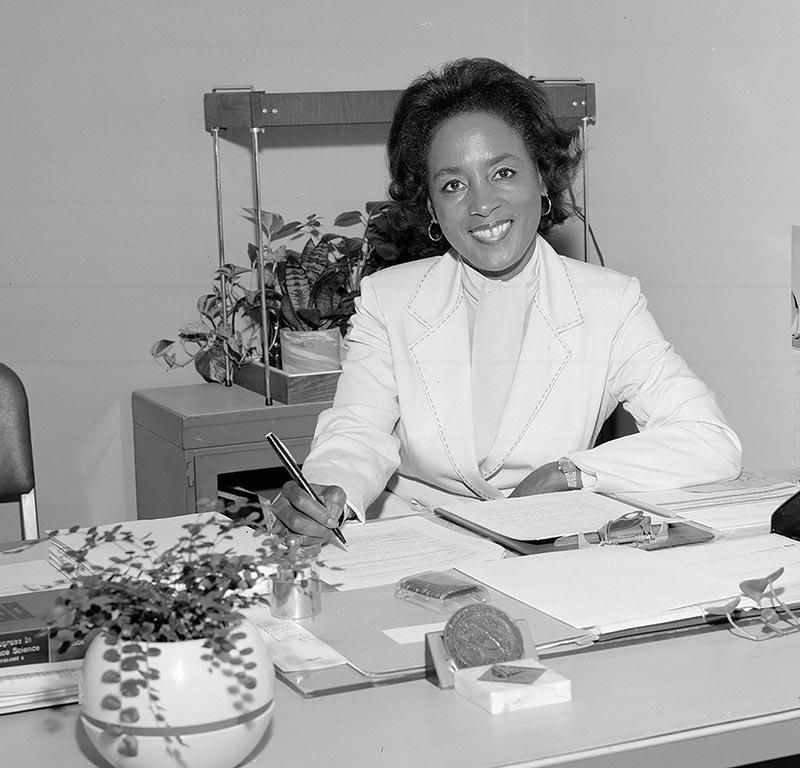Super computing
Article body
Auburn's latest high-performance computer named in honor of pioneering NASA mathematician
In a year of unprecedented changes, the need for strong and powerful computing services, especially those that are accessible remotely, has proven immeasurable. And the ever-growing popularity of these devices now perfectly aligns with the installation of Auburn University’s third-generation supercomputer, Easley.
The first supercomputer on Auburn’s campus, CASIC, was established in 2013 and named after the building in which it resided. When the research efforts across campus established a greater demand for high-performance computing (HPC), a second supercomputer was acquired in 2016 and named Hopper, after the late Rear Adm. Grace Hopper, who was a pioneer of computing technology. This newest addition continues to build on the tradition of meaningful names after Dr. Nick Giordano, dean of the College of Sciences and Mathematics, led the task to find something the community could rally behind and embody. The resulting name, Easley, is in honor of the late Annie Easley, an Alabama native and NASA computer scientist.
Annie Easley was a great believer in education and in following her mother’s admonition, “You can be anything you want to be, but you have to work at it.” Her original plans to become a pharmacist were thwarted after the only program local to her closed, but another door quickly opened. In 1955, after reading an article about twin sisters working as “human computers” for the National Advisory Committee for Aeronautics, Easley applied for a job at the Aircraft Engine Research Laboratory in Cleveland, Ohio (later renamed the NASA Glenn Research Center). Two weeks later, she started her 34-year career as a mathematician and computer engineer. As technology evolved, so did Easley’s job and contributions. Instead of solving the mathematical equations herself, she began developing and implementing computer codes. In addition to playing a major role with the Centaur Upper-Stage Rocket and other shuttle launches, her work was integral in solving energy problems and was invaluable in the improvement of commercially available energy solutions and other technologies.
When asked about the discrimination she faced, Easley stated that she wasn’t trying to pioneer change, but rather just trying to do her job. “I just have my own attitude. I’m here to get the job done.” she said in a 2001 interview for a NASA Oral History. “My head is not in the sand. But my thing is, if I can’t work with you, I will work around you.” In spite of being denied certain benefits and even being cropped from promotional photos, Easley persisted. She ultimately added the role of equal employment opportunity counselor to help others address issues like those she faced. Easley never claimed to be a role model or trailblazer, but in striving to do her best and find answers, she had a tremendous impact on those around her, as well as NASA and computer technology as a whole.
The Annie Easley story is one centered around breaking barriers and pioneering into new eras. The Office of Information Technology hopes to follow her example by introducing the significant computing power held within the Easley supercomputer. The steps to bring this system to life started well before the initial core build in the summer of 2020, and the subsequent installation, configuration and testing that lasted through November 2020. But this new system, officially online as of late November, has 180 individual computing nodes that work together to provide over 500 trillion FLOPs, or floating operation points, per second. That is nearly triple the computational capacity of the Hopper, which was already solving more equations in one second than a human could solve in millions of years. And to store and process this data, Easley has four petabytes of storage and an immense amount of graphics processing power to make sure the system can keep up with all the compelling research coming out of Auburn.
If you’re wondering what could drive the university to invest in such an extensive high performance computing system, it’s important to note that there are over 500 registered users across 34 lab groups currently utilizing these supercomputing processes. These groups span across eight of the 12 academic olleges and schools at the university. Some of the research topics include climate science, bioinformatics, genomics, fluid dynamics, computational chemistry and big data analytics. Together, those teams and projects kept our HPC utilization at approximately 72% throughout 2019, and these research endeavors continued even through the unprecedented trials set forth throughout 2020. As Auburn continues to grow, so will its need for research capacity. The Easley supercomputer establishes that computing power and sets a tone for trailblazing and growth for the years to come.
If you are interested in learning more about high-performance computing at Auburn University, please visit hpc.auburn.edu or email hpcadmin@auburn.edu.


